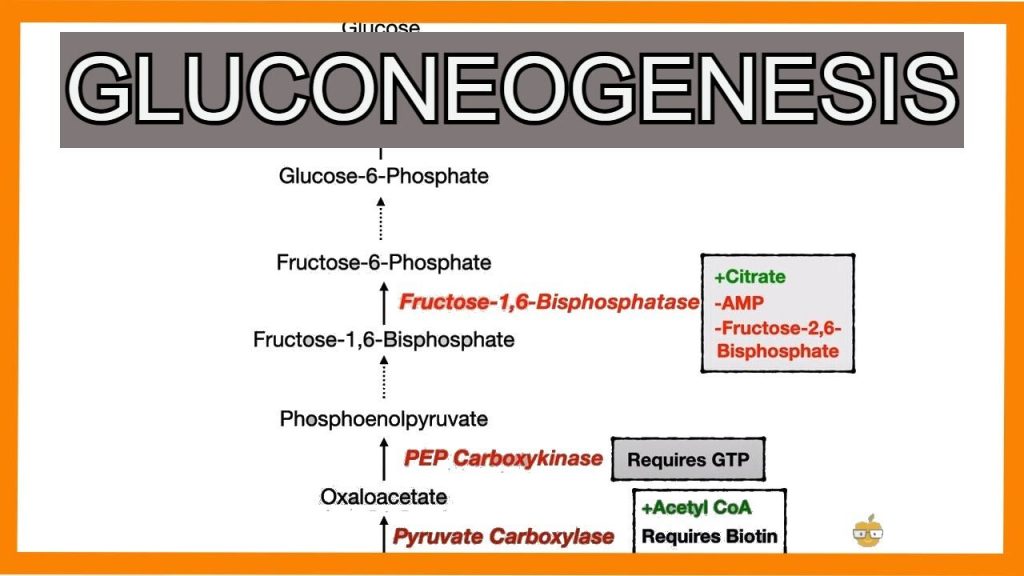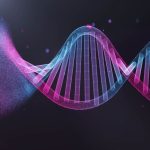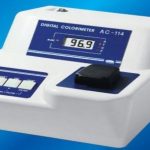Gluconeogenesis is the process of synthesizing glucose from non-carbohydrate sources. The process takes place mainly in the liver and limited extent in the kidney and small intestine under some conditions. It is also called “Endogenous glucose Production” (EGP). It is one of the metabolic pathways. The production of glucose from other carbon skeletons is necessary since the testes, erythrocytes and kidney medulla exclusively utilize glucose for ATP production.
During neoglucogenesis, the Glycogen (the Storage form of Animal Starch) is made with long chains of Glucose molecules. It is broken down into Glucose which then enters the blood.
Basic Definition
The definition of Gluconeogenesis is given below
The biosynthesis of a carbohydrate from simpler, non-carbohydrate precursors such as Oxaloacetate and Pyruvate is called “Gluconeogenesis“.
(or)
“Synthesis of Glucose / Carbohydrates from Non-carbohydrate precursor molecules.”
· The starting point precursor of the pathways is a pyruvic acid molecule, although Oxaloacetic acid and DiHydroxyAcetone Phosphate also provide entry points.
· Lactic acid, it comes from some amino acids metabolism, and Glycerol (from Fat).
· It is similar but not the exact reverse of glycolysis, some of the steps are identical in reverse direction and three of them are new ones.
· Glycolysis and Gluconeogenesis both are a reversible process
· Without going into detail, the general neoglucogenesis sequence is given in the graphic on the left.
· Notice that oxaloacetic acid is synthesized from pyruvic acid in the first step. Oxaloacetic acid is also the first compound to react with acetyl CoA in the citric acid cycle. The concentration of acetyl CoA and ATP determines the fate of oxaloacetic acid.
· If the concentration of acetyl CoA is low and concentration of ATP is high then neoglucogenesis proceeds. Also, notice that ATP is required for a biosynthesis sequence of the pathway.
· Gluconeogenesis occurs mainly in the liver with a small amount also occurring in the cortex of the kidney. It occurs very little in the brain, skeletal muscles, heart muscles or other body tissue. In fact, these organs have a high demand for glucose.
· Therefore, this pathway is constantly occurring in the liver to maintain the glucose level in the blood to meet these demands.
Steps in Gluconeogenesis
Synthesis of glucose from pyruvate utilizes many of the same enzymes as Glycolysis.
Kreb’s pointed out that energy barriers obstruct a simple Reversal of Glycolysis:
1. Between Pyruvate and PEP (Enzymes: Pyruvate Carboxylase and Phosphoenol pyruvate Carboxylase-PEPCK)
2. Between Fructose-1,6-bis P and Fructose-6-P (Enzymes: Fructose-1,6-BisPhosphatse)
3. Between Glucose-6-P and Glucose (Enzymes: Glucose-6-Phosphatase)
4. Between Glucose-1-P and Glycogen (Enzyme: Glycogen Synthase)
Three reactions of Glycolysis have a forward direction that they are essentially irreversible (see lecture notes on Glycolysis):
· Hexokinase (or Glucokinase),
· Phosphofructokinase, and
· Pyruvate Kinase.
These steps must be bypassed in Gluconeogenesis. Two of the bypass reactions involve simple hydrolysis reactions.
Below is the forward reaction catalyzed by each of these Glycolysis enzymes, followed by the bypass reaction catalyzed by the Gluconeogenesis enzyme.

Step 1:
In Glycolysis, First step is Phosphorylation
Glucose + ATP –> Glucose-6-phosphate + ADP
Enzyme: Hexokinase or Glucokinase (Glycolysis)
In Gluconeogenesis, the first step in Glycolysis is reversible.
Glucose-6-phosphate + H2O –> glucose + Pi
Enzyme: Glucose-6-phosphatase

Glucose-6-phosphatase enzyme is embedded in the endoplasmic reticulum (ER) membrane in the liver the cells.
Evidence indicates that the catalytic site is exposed to the ER lumen. Another subunit of the enzyme is postulated to function as a translocase, providing access of substrate to the active site.
In Glycolysis, Step 3 is
Fructose-6-phosphate + ATP –> fructose-1,6-bisphosphate + ADP
Enzymes: Phosphofructokinase

In Gluconeogenesis, the step 3 in glycolysis is reversible.
Fructose-1,6-bisphosphate + H2O –> fructose-6-phosphate + Pi
Enzyme: Fructose-1,6-bisphosphatase
Step 3:
In Glycolysis, the step 9 is
Phosphoenolpyruvate + ADP –> pyruvate + ATP
Enzyme: Pyruvate Kinase
For bypass of the Pyruvate Kinase reaction of Glycolysis, cleavage of 2 ~P bonds is required. The free energy change associated with cleavage of one ~P bond of ATP is insufficient to drive the synthesis of phosphoenolpyruvate (PEP) since PEP has a higher negative DG of phosphate hydrolysis than ATP.

In Gluconeogenesis,
The two enzymes that catalyze the reactions for bypass of the Pyruvate Kinase reaction are the following:
a) PEP Carboxylase Reaction
Pyruvate + HCO3– + ATP –> Oxaloacetate + ADP + Pi
Enzyme: Pyruvate Carboxylase
(b) PEP Carboxykinase Reaction:
Oxaloacetate + GTP –> Phosphoenolpyruvate + GDP + CO2
Enzyme: PEP Carboxykinase
Contributing to the spontaneity of the two-step pathway are the following:
· Free energy of cleavage of one ~P bond of ATP is conserved in the carboxylation reaction. Spontaneous decarboxylation contributes to the spontaneity of the 2nd reaction (PEP synthesis).
· Cleavage of a second ~P bond of GTP also contributes to driving the synthesis of PEP.


